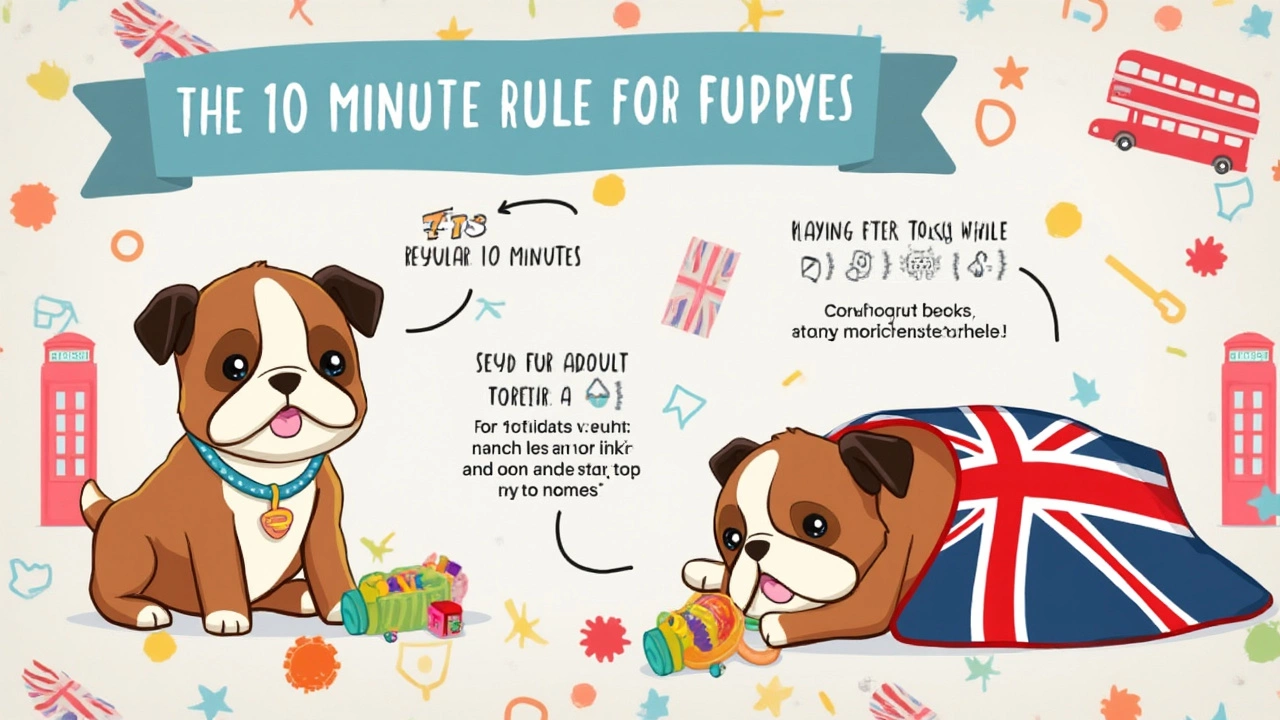Ever seen a puppy play so hard that it suddenly flops down and refuses to budge? That’s not just cuteness overload—it could be a sign your pup’s gone too far. The 10 minute rule is a game-changer if you want your little furball to stay safe, happy, and out of trouble, especially when toys are involved.
This trick is simple: let your puppy play (especially with toys or in the yard) for around 10 minutes at a time, and then give them a break. Sounds easy, but there’s real science behind it. Puppies’ joints and bones are still growing, and long, non-stop play can cause problems down the line—no one wants a puppy limping before its first birthday.
- What Is the 10 Minute Rule?
- Why Puppies Need Play Limits
- Picking the Right Toys for Short Play Sessions
- Recognizing When Your Puppy Needs a Break
- Daily Routines: Making the Rule Work for You
What Is the 10 Minute Rule?
The 10 minute rule is an easy guideline for managing your puppy’s energy and protecting their developing bodies. Basically, it means your puppy should only play or exercise in short bursts—about 10 minutes at a time per session. After that, it’s time for a break, so their joints and muscles don’t get too much wear and tear.
This isn’t just a random number. Vets and dog trainers often recommend the 10 minute rule because a puppy’s bones are still soft, and their muscles tire out quickly, especially when they’re zooming around with toys. The rule is especially useful for puppies under six months old, when their bodies are at that crucial growing stage.
Here’s how the rule usually works in daily life:
- Pick a safe play area—indoors or outdoors
- Set a timer for 10 minutes when your puppy starts playing or running with toys
- When time’s up, stop the activity and offer a break—water, a cuddle, or quiet time
- After the break (10-15 minutes is great), you can do another short play session if your puppy still has energy
People sometimes ask if the 10 minutes includes all activity. No, it’s mostly about high-energy play, fetch games, or wrestling with other dogs and puppy toys. Calm sniffing or slow walks around the yard usually don’t count, unless your puppy gets super riled up.
| Recommended Play for Puppies (by age) | Session Length (minutes) |
|---|---|
| 8-12 weeks | 5-10 |
| 3-6 months | 10-15 |
| 6 months and up | 15-20 |
Sticking to the 10 minute rule means fewer injuries and happier, healthier pups. It also prevents overstimulation—no one wants a cranky puppy who’s too wound up to nap or listen. This rule is super easy to remember and makes daily play with toys fun and safe for everyone.
Why Puppies Need Play Limits
Puppies might act like tiny tornadoes, but their bodies are surprisingly fragile. Their bones and joints are still growing, which means too much exercise or play can actually hurt them. Vets warn that constant running, rough play, or endless fetch sessions can lead to joint issues like hip dysplasia, especially in larger breeds. Injury now can cause lifelong problems, and nobody wants to see their pup limping years down the road.
Another important point: puppies don’t know when to quit. They don’t have an “off switch.” You might notice that young dogs play until they literally drop from exhaustion. That’s why using the 10 minute rule helps—they get to enjoy their toys and play, but with built-in breaks their bodies need. This helps avoid overheating and mental burnout, which is more common than you’d think in active breeds.
Besides joint health, keeping playtimes short also helps with training. Puppies learn to settle and listen to you. It’s much easier for them to focus in short bursts than during random wild play sessions. By capping play, you build in time for rest, potty breaks, hydration, and even a quick cuddle or training cue. That’s how dogs grow up happy, confident, and safe.

Picking the Right Toys for Short Play Sessions
Not every puppy toy fits the 10 minute rule. Small pups can go from playful to overtired fast, so you want to use toys that keep things safe, low-stress, and fun without risk. Look for toys made especially for puppies—avoid anything too hard or heavy that could damage their baby teeth or growing jaw.
The best options are soft rubber toys, plushies (just skip the ones with small parts that could choke), and flexible balls. Brands like KONG make rubber chew toys sized for puppies, which are super popular because you can even fill them with treats for a mental boost. Rope toys are fine as long as your puppy isn’t tearing them apart and eating the bits.
Here’s something research-backed: puppies that play with soft toys are less likely to develop dental problems than those who use human tennis balls, which are too abrasive on their teeth. A 2023 survey of dog owners found that 68% prefer rubber or food-stuffable toys for first-year puppies because they’re safer and more engaging. That’s not just marketing; it’s showing up in households everywhere.
When choosing toys for short play sessions, keep an eye out for:
- Size: Make sure the toy can’t be swallowed but isn’t too heavy for your puppy’s mouth.
- Texture: Softer is better. Hard plastic or real bones are way too tough for growing teeth.
- Washability: Puppies get messy! Pick toys you can toss in the dishwasher or washing machine.
- Interactive options: Toys you can tug or roll across the floor help you join in and monitor playtime.
Just for a quick look, here’s a handy comparison of toy types and why they (or don’t) fit short play sessions:
| Toy Type | Good for 10 Minute Rule? | Key Benefit |
|---|---|---|
| Rubber/Puppy KONG | Yes | Gentle on teeth, mentally engaging, easy to clean |
| Rope Toy | Sometimes | Good for supervised tug, but fraying can be a risk |
| Plushie | Yes | Comforting and soft, but watch out for loose stuffing |
| Tennis Ball | No | Too rough on teeth, can be swallowed |
| Hard Chews/Bones | No | Potential to break teeth and injure gums |
Sticking to the 10 minute rule and using the right toys means your puppy gets to use up energy, learn about its world, and stay safe—all at once. Keep play supervised, switch up the toys now and then, and pay attention if your pup loses interest or gets tired before time’s up. If that happens, just wrap up early, praise your puppy, and save the rest of the fun for later.
Recognizing When Your Puppy Needs a Break
Puppies will play right past the point of tired if you let them, so it’s on you to spot the signals that they need a breather. Knowing when to end a play session isn’t just about looking at a clock; it’s about paying attention to what your puppy is telling you with their body and behavior. Paying attention can make the 10 minute rule way more effective—and it can help you dodge big vet bills from exhaustion or injuries.
Some signs your puppy needs a break:
- Slowing down or flopping onto the floor
- Heavy panting, sometimes even with their tongue hanging way out
- Ignoring toys or walking away from you
- Sudden bursts of the “zoomies” followed by lying flat (that final splat means they’re gassed)
- Yawning, licking lips, or looking dazed—these aren’t just random dog quirks, but real signals
- Crying, whining, or fussiness that wasn’t there at the beginning
One study from the University of Helsinki found puppies get tired after about 10-15 minutes of active play, and rest periods help them learn and recover faster. If you have kids at home who love playing tug or fetch with the puppy, make sure they look for these tired-out signs too. Little humans sometimes want to play longer than puppies should!
When you spot these signs, call a time-out. Offer water. Some dogs benefit from chilling out in their crate or on their bed for 5–10 minutes. Here’s an idea of what a typical puppy’s play and rest pattern might look like during a regular afternoon:
| Activity | Typical Duration (minutes) |
|---|---|
| Active play (with toys) | 10 |
| Rest period | 5-15 |
| Training session | 5 |
| Rest) | 10-20 |
It helps to keep these numbers in mind, but remember—every pup is different. Some might need a break even sooner, especially the tiny breeds or chunky floofs who tire faster. If in doubt, end play early rather than wait for a puppy meltdown. You’ll get to play again soon, and your puppy will thank you by staying bouncy, healthy, and ready to learn more tricks.

Daily Routines: Making the Rule Work for You
Sticking to the 10 minute rule takes a little planning, but it’s not rocket science. Puppies thrive on routine, and short play sessions built into their day keep them happier and healthier. Let’s break down how this works in regular life.
First, set a timer on your phone or smartwatch before play starts. Ten minutes go by shockingly fast, especially if your puppy’s having a blast with their new toy. When the timer rings, swap toys for a cuddle or water break—even a potty trip. This pattern stops them from getting over-tired or wild and makes playtime something they look forward to (instead of dreading when their legs get sore!).
Most trainers suggest young puppies need about 5 minutes of organized activity for every month of age, up to twice a day. So, if your pup just turned three months old, their total playtime shouldn’t really go over 15 minutes at a stretch. Here’s a quick cheat sheet to make things super clear:
| Puppy Age | Max Playtime per Session | Sessions per Day |
|---|---|---|
| 8 weeks (2 months) | 10 minutes | 2–3 |
| 12 weeks (3 months) | 15 minutes | 2 |
| 16 weeks (4 months) | 20 minutes | 2 |
Spread these sessions out to match your schedule. A lot of dog parents find that play before breakfast, after lunch, and early evening works well. Avoid long play sessions late at night unless you want a toddler with zoomies at bedtime.
- Keep favorite puppy toys handy to switch things up.
- Watch your puppy—not the clock—if you notice they’re yawning, lying down, or getting mouthy, it’s definitely break time.
- Pair play with other bits of the daily routine, like after potty breaks or before meals.
Most puppies will nap soon after play if you stick to short bursts. You’ll notice fewer tantrums, less chewing on shoes, and their energy stays more balanced. This little bit of planning each day pays off really fast—the secret sauce for raising a well-adjusted, happy dog.

